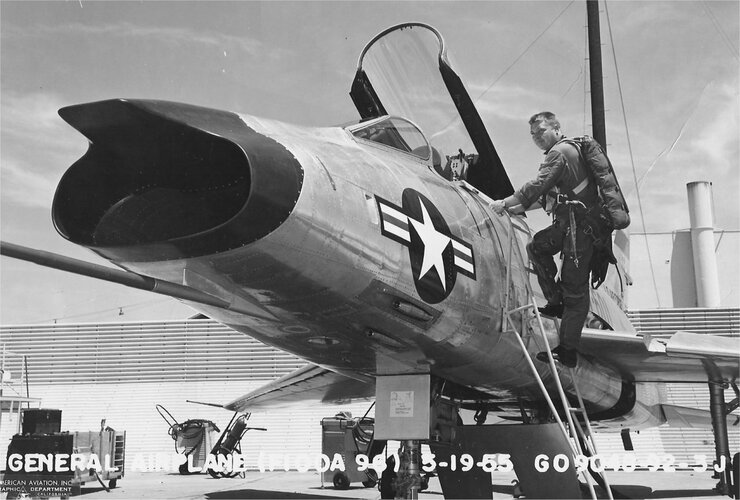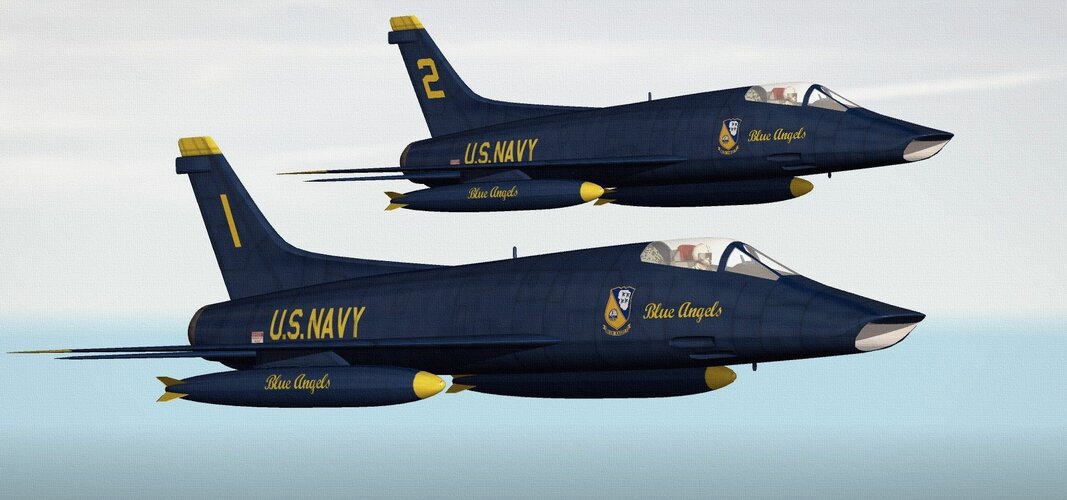You are using an out of date browser. It may not display this or other websites correctly.
You should upgrade or use an alternative browser.
You should upgrade or use an alternative browser.
F-100A: what's going on here?
- Thread starter Sabrejet
- Start date
- Joined
- 19 February 2007
- Messages
- 1,441
- Reaction score
- 2,677
GO-9048 means General Order 9048, the North American Aviation charge number (internal accounting code) to which this work was billed (others included SO - Sales Order and so on.) This looks to house an enlarged feed horn for the APG-30 gun ranging radar. (This system provided range data to the gun sight for trajectory lofting and correction.)
- Joined
- 27 December 2005
- Messages
- 17,749
- Reaction score
- 26,424
There's an enlarged bulge on the top where the AN/APG-30 radar lives. I checked all my F-100 books, couldn't find anything.
Last edited:
- Joined
- 1 April 2006
- Messages
- 11,397
- Reaction score
- 10,311
First that gives you googling for F-100A "53-1601"
 friendsofthesupersabre.org
friendsofthesupersabre.org
F-100A 53-1601
Modified nose cone in an attempt to improve thrust of the J57-7 engine.
Hmm..
Rare Hun Pictures - Friends of the Super Sabre
F-100A 53-1601
Modified nose cone in an attempt to improve thrust of the J57-7 engine.
Hmm..
Attachments
- Joined
- 16 January 2015
- Messages
- 791
- Reaction score
- 3,605
Flateric beat me to it, I was going to post the same link.
On the other hand, NAA was working on proposals to change the fire control radar that would have sported a similar "beak", like on the F-100J. See here for more.

And Elmayerle (in a post below in the same thread) talks about a "picture I saw of a modified F-100 with the gunsite radar replaced by a more capable one, resulting in a bulged radome on the top of the inlet."
In 1964, though, it appears that despite whatever testing modification 53-1601 had undergone, it was returned to a more usual look and was in service with the Connecticut ANG.
On the other hand, NAA was working on proposals to change the fire control radar that would have sported a similar "beak", like on the F-100J. See here for more.
And Elmayerle (in a post below in the same thread) talks about a "picture I saw of a modified F-100 with the gunsite radar replaced by a more capable one, resulting in a bulged radome on the top of the inlet."
In 1964, though, it appears that despite whatever testing modification 53-1601 had undergone, it was returned to a more usual look and was in service with the Connecticut ANG.
- Joined
- 27 December 2005
- Messages
- 17,749
- Reaction score
- 26,424
Hmm, I tried F-100A 53-1601 without quotes and didn't get much but Google had done its usual recent trick of excluding the second search term 53-1601 and just given me results for F-100A on the first page. Must use quotes!
- Joined
- 16 April 2008
- Messages
- 9,608
- Reaction score
- 14,502
Hmm, I tried F-100A 53-1601 without quotes and didn't get much but Google had done its usual recent trick of excluding the second search term 53-1601 and just given me results for F-100A on the first page. Must use quotes!
Also, I generally get better results if I select "Verbatim" from the Tools section of Google Search. It should cut out most of the "Did you really mean" results that Google likes to shove in because normal users write bad searches (and because they can place more ads that way).

- Joined
- 25 June 2009
- Messages
- 14,754
- Reaction score
- 6,155
I had never noticed this "Verbatim" option until now! I generally use quotes and boolean. Thanks for the tip.Also, I generally get better results if I select "Verbatim" from the Tools section of Google Search. It should cut out most of the "Did you really mean" results that Google likes to shove in because normal users write bad searches (and because they can place more ads that way).
View attachment 725197
- Joined
- 16 April 2008
- Messages
- 9,608
- Reaction score
- 14,502
I had never noticed this "Verbatim" option until now! I generally use quotes and boolean. Thanks for the tip.
My pleasure. I literally search Google for my day job (among many other tools) so I've learned a few ins and outs.
Another thing to keep in mind is that the same Google search terms will produce different results for different people, based on your location, past search history, etc. I seem to get better results than some other folks because I generally follow links to certain kinds of pages (high-content, less SEO, for example), so Google serves more of those in future searches.
Verbatim "mot a mot" - thanks for the tip @TomS !!I had never noticed this "Verbatim" option until now! I generally use quotes and boolean. Thanks for the tip.
The extended inlet “lip” is reminiscent of the proposal for a “Super Fury” (which was, of course, based on the Super Sabre) that North American put forward in the competition that resulted in the F-8 Crusader, as shown in post #91 in this thread.
I’d link it directly, but I’m on my phone and it’s not cooperating.
At any rate, it looks like North American found a design element they liked.
I’d link it directly, but I’m on my phone and it’s not cooperating.
At any rate, it looks like North American found a design element they liked.
T. A. Gardner
ACCESS: Top Secret
- Joined
- 18 February 2021
- Messages
- 1,152
- Reaction score
- 2,024
53-1601, according to the Baugher serial number list ended up being sold to Taiwan, so it's possible the mod was done for that reason and similar to the one shown for a Japanese F-100.Flateric beat me to it, I was going to post the same link.
On the other hand, NAA was working on proposals to change the fire control radar that would have sported a similar "beak", like on the F-100J. See here for more.

And Elmayerle (in a post below in the same thread) talks about a "picture I saw of a modified F-100 with the gunsite radar replaced by a more capable one, resulting in a bulged radome on the top of the inlet."
In 1964, though, it appears that despite whatever testing modification 53-1601 had undergone, it was returned to a more usual look and was in service with the Connecticut ANG.
To avoid confusion, 53-1601 saw a number of service assignments before it ended up in Taiwan, so that aspect is a red herring. Baugher's site is useful as a starting point, but is missing a lot of detail, which should be:
F-100A s/n 53-1601 for Project AMC-4F-531
Available 17Nov55
Accepted 13Dec55
Delivered 28May55
North American Inglewood 27May55 (bailment test)
Redesignated JF-100A 28Nov55
Redesignated F-100A 07Aug57
3595th Combat Crew Training Wg, Nellis AFB 09Aug57 (student and combat crew training)
Redesignated JF-100A 01Apr58
San Bernardino Air Materiel Area, Norton AFB 16Jul58 (depot work)
4520th CCTW, Nellis AFB 23Oct58 as F-100A (student and combat crew training)
Sacramento Air Materiel Area, McClellan AFB as JF-100A 16Mar59 (storage)
North American Inglewood 13Apr59 (contract work)
118th TFS, CT ANG Bradley 08Jul59
Redesignated F-100A 20Aug59
North American Inglewood 05May60 (contract work)
118th TFS CT ANG Bradley 20Jun60 (118th FIS from 03Jan62; 103rd FGp Bradley etc)
Davis Monthan 09Feb66 (storage)
North American Inglewood 06Feb70
Sacramento Air Materiel Area, McClellan AFB 10Nov70
To Military Assistance Program 08Dec70, to RoCAF as 0222
The only minor anomaly is that its 'JF' (temporary special test/TO exemption) designation was reinstated for assignment to Nellis in August 1957 despite its mission being 'student and combat crew training' at that time. It's possible that Nellis was used as a service-test location for something at that point (similar was done with Gun-Val F-86Fs at CCTWs; also TF-86F trainer), but equally it's feasible that it was done to signify that this aircraft would be TO-exempt until it could be routed to a Depot for rework/mod (done in July 1958).
F-100A s/n 53-1601 for Project AMC-4F-531
Available 17Nov55
Accepted 13Dec55
Delivered 28May55
North American Inglewood 27May55 (bailment test)
Redesignated JF-100A 28Nov55
Redesignated F-100A 07Aug57
3595th Combat Crew Training Wg, Nellis AFB 09Aug57 (student and combat crew training)
Redesignated JF-100A 01Apr58
San Bernardino Air Materiel Area, Norton AFB 16Jul58 (depot work)
4520th CCTW, Nellis AFB 23Oct58 as F-100A (student and combat crew training)
Sacramento Air Materiel Area, McClellan AFB as JF-100A 16Mar59 (storage)
North American Inglewood 13Apr59 (contract work)
118th TFS, CT ANG Bradley 08Jul59
Redesignated F-100A 20Aug59
North American Inglewood 05May60 (contract work)
118th TFS CT ANG Bradley 20Jun60 (118th FIS from 03Jan62; 103rd FGp Bradley etc)
Davis Monthan 09Feb66 (storage)
North American Inglewood 06Feb70
Sacramento Air Materiel Area, McClellan AFB 10Nov70
To Military Assistance Program 08Dec70, to RoCAF as 0222
The only minor anomaly is that its 'JF' (temporary special test/TO exemption) designation was reinstated for assignment to Nellis in August 1957 despite its mission being 'student and combat crew training' at that time. It's possible that Nellis was used as a service-test location for something at that point (similar was done with Gun-Val F-86Fs at CCTWs; also TF-86F trainer), but equally it's feasible that it was done to signify that this aircraft would be TO-exempt until it could be routed to a Depot for rework/mod (done in July 1958).
Similar threads
-
-
-
-
What if yak-141 fleet instead?
- Started by helmutkohl
- Replies: 15
-



